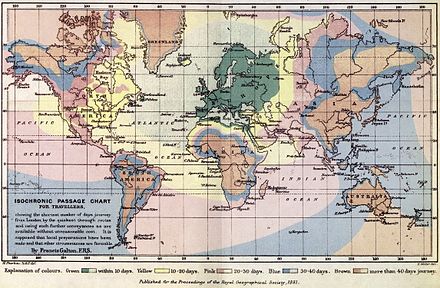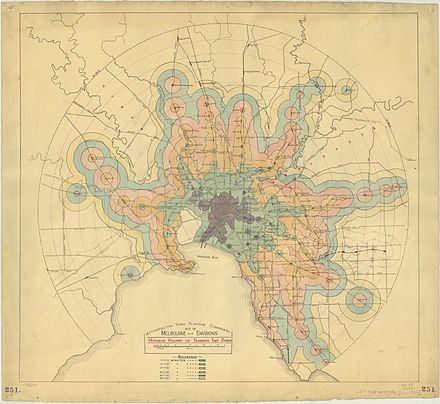Isochrone map

An isochrone map in geography and urban planning is a map that depicts the area accessible from a point within a certain time threshold.[1] An isochrone (iso = equal, chrone = time) is defined as "a line drawn on a map connecting points at which something occurs or arrives at the same time".[2] In hydrology and transportation planning isochrone maps are commonly used to depict areas of equal travel time. The term is also used in cardiology[3][4][5] as a tool to visually detect abnormalities using body surface distribution.[6]
History


Early examples of Isochrone maps include the Galton's Isochronic Postal Charts and Isochronic Passage Charts of 1881 and 1882,[7] Bartholomew's Isochronic Distance Map and Chart first published 1889,[8] and Albrecht Penck's Isochronenkarte first published 1887.[9] Where as Galton and the Bartholomews published maps depicting the days or weeks it took to travel long distances, Albrecht further developed the idea to not only depict long distances and world travel but also smaller areas. Penck also created a series of maps that only depict the travel times of a certain transportation mode, for example Rail transport. Isochrone maps are commonly used in the UK in connection with development control.[10][11][12][13] Isochrones are currently typically computed by via generating shortest-path trees on network graphs, and then generating a convex hull around the accessible nodes. Increases in computation, data storage, and improvements in algorithms have facilitated the rapid generation of isochrones.[1][14] Recent techniques in visualization include linking travel times to network edges to show the paths accessible from a point rather than show the area accessible from a point.[1]
Usage
Hydrology
Isochrone and related maps are used to show the time taken for runoff water within a drainage basin to reach a lake, reservoir or outlet, assuming constant and uniform effective rainfall.[15][16][17][18] An early example of this method was demonstrated by Clark in 1945.[19]
Transport planning
Isochrone maps have been used in transportation planning since at least 1887.[20][21] Isochrone maps in the context of transport planning are essentially maps of accessibility where travel time is used as the cost metric. Isochrone maps can be created for different modes of transportation,[22] e.g. foot, bicycle, motor vehicle. Put simply, the output of an isochrone map for transport will show how far (in distance) is reachable from a start point, including the parameter of time.
Such maps for private motor transport were widely used in a 1972 study into airport accessibility in Hampshire, South East England.[23] At that time, their use was disadvantaged by being time-consuming to create.[23]
The term isodapane map is used to refer to a map were the contour represent transportation cost instead of transportation time.[24]

General public
Journey time websites have been built using mapping technologies and open data.[25][26] Isochrones can be used by house hunters wishing to evaluate residential areas.[27] An isochrone map of the London Underground network was made available in 2007.[28]
Services and applications
Several digital tools exist which can generate isochrone maps.
openstreetmap-based solutions:[29]
- CommuteTimeMap - lets to build and visualize isochrones worldwide
- Geoapify Isochrone API - API service to build isochrones for drive, truck, bicycle, walk and transit modes. Worldwide.
- GraphHopper [1][2] can be used to calculate a detailed time information for every point within a certain time or distance reach.
- GRASS v.net.iso module
- instaGIS[30]
- Iso4App Public Transport Isochrone maps (Isochrones based on GTFS data)
- Mapbox Isochrone API (interactive Mapbox example)
- Mapumental
- OpenRouteService Isochrones Service - uses OSM data and map, shows isochrones worldwide (no source code available)
- OpenTripPlanner - a development branch has work on an Analytics Extension, which currently provides isochrones based on the OSM network and GTFS data (source code available)
- OSRM Isochrone Generate drivetime isochrones from OSM using OSRM.
- pgRouting The creation of journey time isochrones to airports in Finland has been explained using the GIS software QGIS and pgRouting (an extension of PostGIS).[31]
- pysochrone is a Python script and simple web interface for computing and displaying isochrones from an OGR-supported data source (e.g. PostGIS)
- Reachability Analysis An application (built using WhereOS and OSM data) which calculates reachability (isochrone) from given set of addresses.
- Safe Routes to School Mapping Toolkit - working to create travel distance/time web app for pedestrians and bicyclists using OSM data (source code available)
- TargomoAPI - Travel times, Routing, Points of Interests, Isochrones - developer tools to build state-of-the-art geospatial analytics applications, enhance location search, and personalize user experience. (Interactive Demo)
- TravelTime API[32] Uses some OSM Data and has a free isochrone generator tool using public transport, cycling, walking, driving and combined bike & train. Available as a plugin for QGIS and ArcGIS.
- Valhalla isochrone service
- Walkscore Travel Time API - uses GTFS and OSM data for maps of Seattle, San Francisco, and Washington DC. Built on the open source Graphserver library. (no source)
- WNYC Transit Time - public transit isochrones for NYC
GTFS-based solutions:
- Mapnificent[25][33][34]
Proprietary data solutions:
- Google Maps API
- PedCatch
See also
- Daily urban system
- Public transport timetable
- Traffic congestion map
- Transit map
- Walking distance measure
References
- ^ a b c d Allen, Jeff (2018-12-01). "Using Network Segments in the Visualization of Urban Isochrones". Cartographica: The International Journal for Geographic Information and Geovisualization. 53 (4): 262–270. doi:10.3138/cart.53.4.2018-0013. ISSN 0317-7173. S2CID 133986477.
- ^ Desai, Kiran (17 October 2008). "Isochrones: Analysis of Local Geographic Markets" (PDF). Mayer Brown. Retrieved 2018-05-31.
- ^ "MFS ECG Potential Map (40ms)". Springer Science+Business Media. Retrieved March 21, 2012.
- ^ Rosenbaum, David S.; Jalife, José (2001). Optical mapping of cardiac excitation and arrhythmias. Wiley-Blackwell. p. 251. ISBN 0879934816.
- ^ Ramanathan, Charulatha; Jia, Ping; Ghanem, Raja; Ryu, Kyungmoo; Rudy, Yoram (April 2006). "Activation and repolarization of the normal human heart under complete physiological conditions". PNAS. 103 (16): 6309–6314. Bibcode:2006PNAS..103.6309R. doi:10.1073/pnas.0601533103. PMC 1458874. PMID 16606830.
- ^ Miyashita, T; Okano, Y (January 1995). "Isochrone map, its implication and clinical usefulness". Nihon Rinsho: Japanese Journal of Clinical Medicine. 53 (1): 48–55. PMID 7897854.
- ^ Galton, Francis (1881). "On the Construction of Isochronic Passage Charts". Proceedings of the Royal Geographical Society. Royal Geographical Society: 657. doi:10.2307/1800138. JSTOR 1800138.
- ^ Bartholomew (1889). Atlas of Commercial Geography. Edinburgh: John Bartholomew and Son. p. S. VI, Map 13 a.
- ^ Penck, Albrecht (1887). "Isochronenkarte der österreichisch-ungarischen Monarchie". Deutsche Rundschau für Geographie und Statistik: 337.
- ^ "Planning for Town Centres; Practice guidance on need, impact and the sequential approach" (PDF). Department for Communities and Local Government. December 2009. Retrieved March 26, 2012.
- ^ "Transport Assessment; Guidelines for Development Proposals in Northern Ireland" (PDF). Department for Regional Development. November 9, 2006. Retrieved March 26, 2012.
- ^ "Technical Guidance on Accessibility Planning in Local Transport Plans" (PDF). Local Transport Planning Network. Archived from the original (PDF) on November 20, 2007. Retrieved March 26, 2012.
- ^ Barker, Kate (December 2006). "Barker Review of Land Use Planning" (PDF). Retrieved March 26, 2012.
- ^ Bolzoni, Paolo; Helmer, Sven; Lachish, Oded (2016). "Fast Computation of Continental-Sized Isochrones". International Conference on GIScience Short Paper Proceedings. 1 (1). doi:10.21433/B31171h533kp.
- ^ Bell, V. A.; Moore, R. J. (1998). "A grid-based distributed flood forecasting model for use with weather radar data: Part 1. Formulation" (PDF). Hydrology and Earth System Sciences. 2 (2/3). Copernicus Publications: 265–281. Bibcode:1998HESS....2..265B. doi:10.5194/hess-2-265-1998.
- ^ Subramanya, K (2008). Engineering Hydrology. Tata McGraw-Hill. p. 298. ISBN 978-0070648555.
- ^ "EN 0705 isochrone map". UNESCO. Archived from the original on November 22, 2012. Retrieved March 21, 2012.
- ^ "Isochrone map". Webster's Online Dictionary. Archived from the original on January 13, 2013. Retrieved March 21, 2012.
- ^ "Unit Hydrograph (UHG) Technical Manual". National Oceanic and Atmospheric Administration. Retrieved March 21, 2012.
- ^ "Mapping Manchester project". October 2013. Retrieved May 5, 2014.
- ^ "Dissertation of Johannes Riedel". Thomas & Hubert. 1911.
- ^ Gamper Johann; Böhlen, Michael; Cometti, Willi; Innerebner, Markus (2011). "Defining isochrones in multimodal spatial networks". Proceedings of the 20th ACM international conference on Information and knowledge management. CIKM. Glasgow. doi:10.1145/2063576.2063972. ISBN 9781450307178. Retrieved March 21, 2012.
- ^ a b Armstrong, H. W. (September 1972). "A Network Analysis of Airport Accessibility in South Hampshire" (PDF). Journal of Transport Economics and Policy. 6 (3): 294–307. ISSN 0022-5258.
- ^ Barthwal, R. R. (2007). Industrial Economics: An Introductory Text Book. New Age International. ISBN 9788122412789.
- ^ a b "Looking for the best commuter route to Salford Quays? Stefan in Berlin can help with that". Manchester Evening News. June 7, 2011. Archived from the original on June 14, 2011. Retrieved March 22, 2012.
- ^ Hartley, Sarah (February 24, 2011). "Greater Manchester datastore launched". The Guardian. Retrieved March 22, 2012.
- ^ "House-hunting goes hi-tech". The Independent. November 25, 2009. Retrieved March 22, 2012.
- ^ DrAlanRae (July 25, 2007). "Getting about – Isochrone map of London Underground". howtodobusiness.com. Archived from the original on April 17, 2012. Retrieved March 21, 2012.
- ^ "Isochrone - OpenStreetMap Wiki". wiki.openstreetmap.org. Retrieved 2021-09-09.
 Text was copied from this source, which is available under a Creative Commons Attribution-ShareAlike 2.0 Unported license.
Text was copied from this source, which is available under a Creative Commons Attribution-ShareAlike 2.0 Unported license.
- ^ "instaGIS: Discovering Isochrones". instaGIS. Retrieved 1 September 2014.
- ^ Graser, Anita (February 12, 2011). "Drive Time Isochrones – An Example Using Finnish Airports". Retrieved March 22, 2012.
- ^ Contributor, G. I. S. (2016-07-09). "Using the TravelTime Search API to Generate an Isochrone". GIS Lounge. Retrieved 2020-06-22.
{{cite web}}:|last=has generic name (help) - ^ N.B. (Jun 5, 2011). "A time-based transit map". The Economist. London. Retrieved March 22, 2012.
- ^ O'Brien, Terrence (August 5, 2011). "Mapnificent visualizes public transportation travel time, is more exciting than it sounds". Engadget. Retrieved March 22, 2012.